Writing Forgotten New York, the book, was an exhausting yet exhilarating experience. There were a lot of hours hunched over a keyboard in my non-air conditioned living room, but as many hours as I spent indoors on revisions, there were engaging hours spent outside with my camera capturing scenes that made their way onto the pages. I gave my editor Matthew Benjamin enough for a 700-page book (better to have too much than not enough), and it was necessary to cut quite a bit. Some may find their way to Son of Forgotten New York if it ever appears, but, as we’ll see on this page, some of the scenes I captured for the book are gone forever in New York’s changing scene….
I was asked to essay black and white photography for the book, and after an experimentation with black and white film which I rejected because I couldn’t get free film when I got the rolls developed (your webmaster was on a budget while unemployed) I then switched to using my digital Olympus (PowerShot S1 IS) and manipulating the shots in Photoshop to remove the color. This, too, I dropped and switched to a Canon film camera and delivered stacks and stacks of photo “hard copies” to HarperCollins. That way, they could scan the pictures to their own specifications, and photo editor Jessica Paskay did a terrific job with your webmaster’s occasionally smudged, shadowy and blurry attempts at photography.

AMSTERDAM AVENUE and WEST119th STREET, Manhattanville. This is one of Manhattan’s 3 remaining Croton Aqueduct gatehouses.. This is a small granite building with a slate roof. It was recently designated a NYC landmark, all but precluding its demolition or alteration.

TIMES PLAZA (Atlantic, 4th and Flatbush Avenues), Fort Greene, Brooklyn. Atlantic Avenue‘s is one of the few station houses remaining from the subways’ early days: it was designed by subway contractors Heins and LaFarge and placed here in 1908 when the subways first forayed into Brooklyn. After several years in the wilderness, when it served as a hotdog stand with garish neon signage, it settled into a tattered, neglected old age, covered in graffiti and peeling paint.
In 2003, during a complete renovation of the subway construction beneath, it was restored to full glory (though it now stands isolated in a traffic island with no entrances at all) and given a skylight above a station staircase. It’s meant, though, to be viewed from across the street and serves no practical purpose other than filigree.
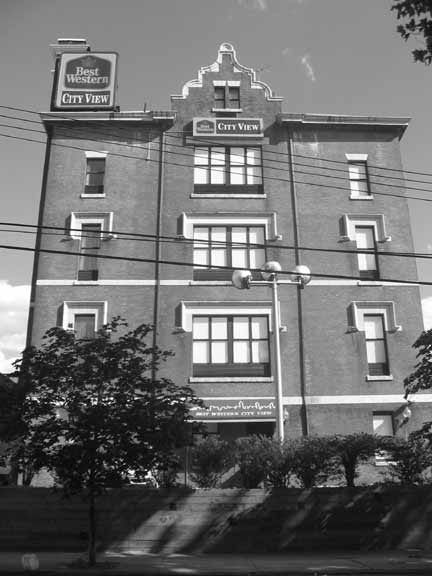
GREENPOINT AVENUE, Blissville, Queens. The City View Best Western Hotel is a former public school, and does indeed boast an impressive city view on the Manhattan-facing side. I’ve read it has a rep as a hot sheets kind of place. When I called the receptionist and asked for a room with a city view, she thought I was trying to be funny. But I wanted to stay in a Manhattan-facing room. For the city view.
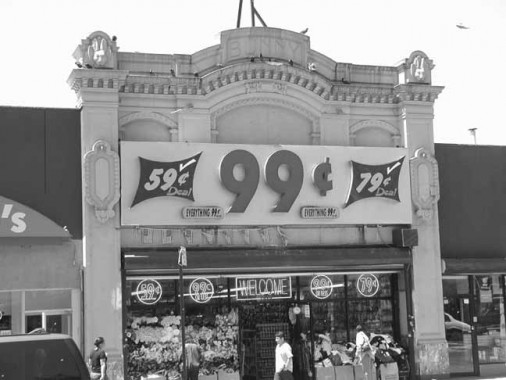
BROADWAY and WEST 147th STREET, Hamilton Heights. The Bunny Theatre has nothing to do with Bugs or Hef, but is instead named for early 1900s vaudeville impresario-comedian John Bunny, who used his hefty girth to great effect in over 100 silent shorts. It became the Nova and closed a few years ago, but, for now, the building remains.
[Sadly, the building had been shorn of its bunnies by 2010]
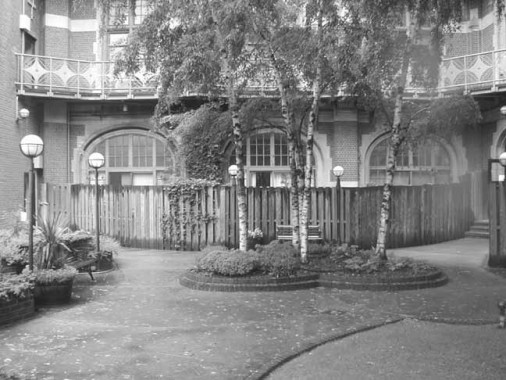
ATLANTIC and WASHINGTON AVENUES, Clinton Hill. Thanks to a present resident at 555 Washington, Linda Piechota, I was able to gain entrance to my old high school, Cathedral Prep. The school has been converted to condos, while the inner courtyard is now a general sitting area. Not a great deal has been altered from the old days here, but the schoolrooms have been subdivided into apartments.

CONOVER and REED STREETS, Red Hook, 2002. Bob Diamond‘s dreams of a trolley museum and a trolley line to Brooklyn Heights along Columbia Street are silent for now, but things looked quite rosy for him back in 2000, when he actually got tracks laid along the waterfront and Conover and Reed Streets. When Diamond ran out of money, the city withdrew its support for the project and took up the tracks and repaved the streets. A grant for a feasibility study was obtained in 2010, but, again, nothing.
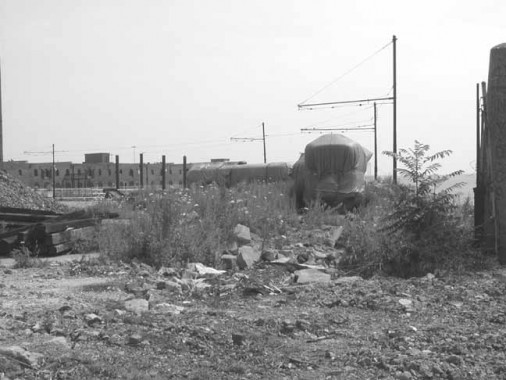
Diamond’s trolley cars, salvaged from Boston’s Green Line, remained in place on tracks along the waterfront until early 2006; a waterside pedestrian path, and a parking lot for the new Fairway supermarket, occupy this space now. The cars sit rusting behind the Fairway Supermarket opened in 2006.

CARROLL STREET west of Franklin Avenue, Prospect Heights. The iron Carroll Street Bridge, replacing an earlier span in 1994, carries the street over the open cut of the Franklin Shuttle.
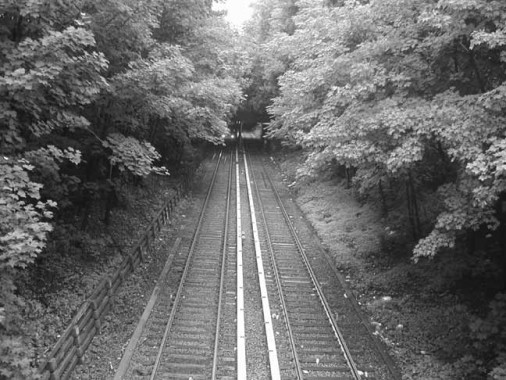
The Franklin Shuttle here looks like a rural or suburban railroad, which is what it was when it began life as the Brooklyn, Flatbush and Coney Island Railway in 1877, during the Hayes administration.
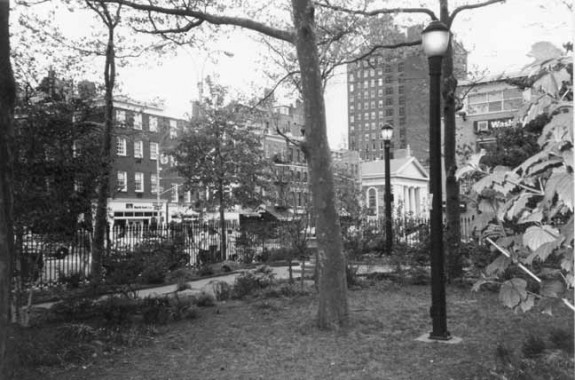
SIXTH AVENUE and West 4th Street, Greenwich Village. Golden Swan Park is named for a tavern that used to be there on the site. It was frequented by Eugene O’Neill, who used it as a model for some of the bars that turned up in his plays.
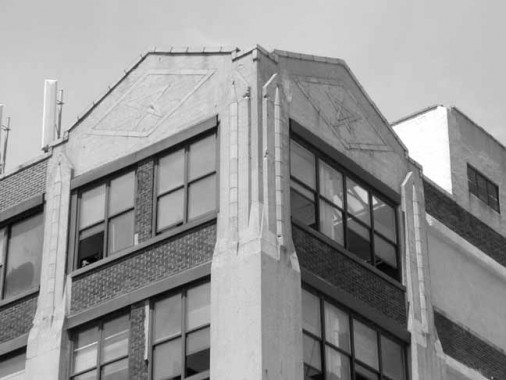
FRANKLIN STREET and Greenpoint Avenue, Greenpoint. The old Eberhard Faber pencil factory sports four terra cotta pencils on the corner building, along with the company’s star symbol. Yes, the pencils are yellow.

HIGH BRIDGE, connecting Washington Heights in Manhattan and Morris Heights in the Bronx, is the oldest river-spanning bridge in NYC. It was built as a water conduit as part of the croton Aqueduct system from 1837-1848. It has never carried vehicular traffic, but its pedestrian walkway has been closed since 1960. photo: Mike Epstein
[High Bridge is apparently going to be restored and will reopen by the end of the 2010s, but that tune has been played before.]

The High Bridge Water Tower, built in 1872, was originally used to equalize water pressure from the Croton Aqueduct.
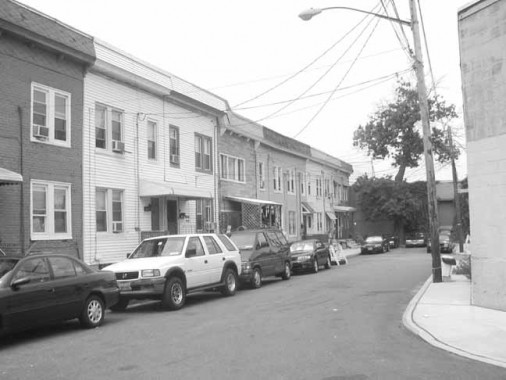
LINNEAUS PLACE, Flushing, Queens. Likely the only street in New York City named for a Swedish botanist (Carl von Linné), Carolus Linneaus (1707-1778) developed the modern taxonomic naming system used by scientists for living species (i.e. Homo sapiens, “wise man” for our human species). The C-shaped alley in Flushing, off Prince Street north of 35th Avenue, also takes its name from the Linnaean Gardens, the nation’s first commercial plant nursery run by Robert Prince and his son William beginning in 1735. Though it had gone out of business by the 1860s, other nurseries including James Bloodgood’s and Robert Parsons thrived until the 20th Century. Adams, Washington and Jefferson all visited the Prince plant nursery, with Jefferson being the most enthusiastic customer.
There aren’t many remnants of these plant businesses left in Flushing except for the street naming system, which runs from Ash to Rose, and a stand of trees in Kissena Park opposite Parsons Boulevard. This little alley reminds us that Prince Street, named for the businessman, was originally named Linneaus Street, for the scientist.

MONTAGUE STREET at Clinton Street, Brooklyn Heights. These octagonal-shaped station entrance luminaires were developed by the Brooklyn Rapid Transit Company (the BRT – predecessor of the BMT) and placed along the 4th Avenue Brooklyn line in 1916 when the line was opened. This is one of a pair that has been lovingly restored and put back to its original location at the Court Street station.
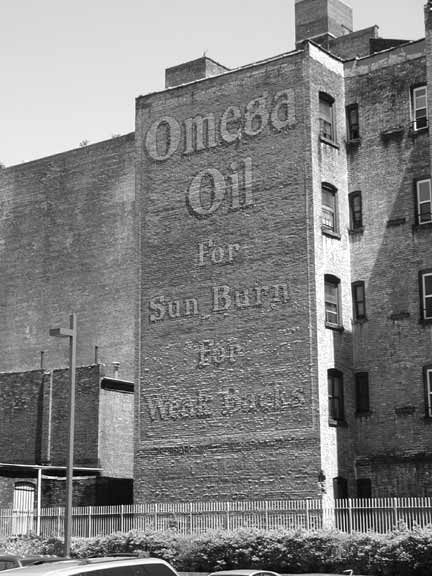
WEST 147th STREET, east of Frederick Douglass Boulevard (8th Avenue), Hamilton Heights. Omega Oil was an “all-purpose” liniment sold in the first couple of decades of the 20th Century. There are still fading Omega Oil ads around town, but this one, part of a tryptich facing a police precinct parking lot, is by far the most spectacular. Since it faces police property, the cops do not allow photography there, so you have to be cagey and shoot from across 147th Street, as was done here.

NORTHERN BLVD. and LINDEN PLACE, Flushing. The Quaker Meetinghouse has been used for religious services since 1695, when it was built (except for a brief period garrisoning British soldiers during their NYC occupation from 1776-1783).
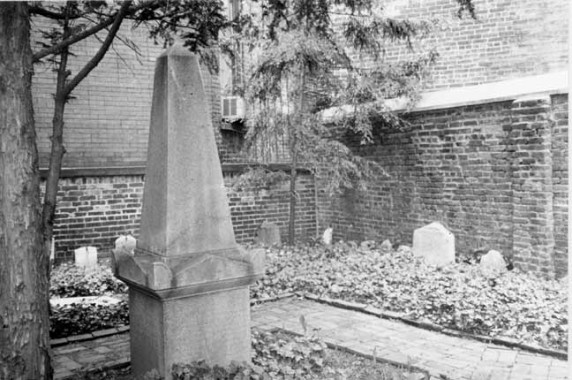
WEST 11th STREET just east of 6th Avenue, Greenwich Village. When 11th Street was built here in the early 1800s it displaced about half of the small Shearith Israel cemetery that had been here from colonial days. The remains were disinterred and placed in a new Shearith Israel cemetery on West 21st Street just west of 6th. That cemetery, as well as this small triangular plot, what is left of the original cemetery, remain in place. An even older Shearith Israel Cemetery, dating to the late 1600s, can be found on St. James Place just south of Chatham Square.

FLATBUSH & 5TH AVENUES at DEAN STREET, Park Slope. Diagonal streets produce distinctive architecture, as architects build oddly-shaped buildings to fit odd-shaped plots. The Flatiron Building at 5th Avenue and 23rd Street in Manhattan is the city’s most famous “triangle” building, but this one is home to the long-time sporting goods store named for its shape.
[2012: Triangle Sports has moved out and the building is for sale]

ATLANTIC and 5TH AVENUES, Park Slope/Fort Greene. Samuel Underberg, a food supplies company, had offices in this building for many decades, and the company made sure you knew it with large painted identification on all sids of the building. Some years ago, Underberg moved down Atlantic Avenue to Utica Avenue, and the building, and its signs, lay empty. In early 2006, it was razed by Forest City Ratner in anticipation of using the land for its Atlantic Yards project. “Underberg” was used by Jonathan Lethem for the first section of his novel “The Fortress of Solitude.”
Satanslaundromat at Atlantic Yards (2003)
[this site is now occupied by the new Barclays Center]
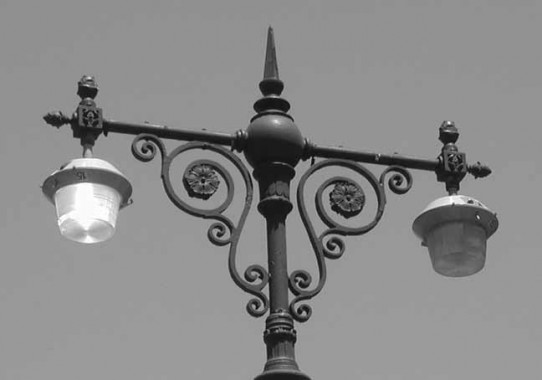
AMSTERDAM AVENUE at HAMILTON PLACE, Hamilton Heights. We’ve seen how a triangular plot can produce distinctive architecture. A triangle formed by the abovenamed avenues and West 143rd Street is graced by the last remaining of what I call “imperial” Twinlamp castiron lampposts, which featured regular Type 24 Twin brackets accentuated by extra ironwork at their crests, such as the spike shown here, and a miuch heavier fluted base, which were used at important intersections. Unfortunately, while in the rest of the city castirons or their retro modern cousins sport esthetically pleasing reproductions of classic luminaires, this post still carries ungainly 1980s “bucket” sodium fixtures.

ST. NICHOLAS AVENUE south of WEST 145TH STREET. Between 1960 and 1982 the WABC “All-Americans,” led by Dan Ingram and Cousin Bruce Morrow, spun stacks of wax and helped usher in music’s “British Invasion” led by the Beatles. By 1982 the format had become less popular and the format changed to all-talk. This ad on Amsterdam Avenue dates to the mid-1970s. In late 2005, WABC brought back the Musicradio format…on Saturday nights between 6 and 10PM. Fun fact: The WABC DJ’s were originally collectively known as the “Good Guys”…a nickname appropriated by WMCA‘s mid-60s deejay cast, which made it much more famous.

UNIVERSITY and SEDGWICK AVENUES, Morris Heights. A look skyward at a building at Sedgwick Avenue and University Avenue (Martin Luther King Blvd.) reveals a 30-foot tall lighthouse cast in bronze. It is the home office of the H.W. Wilson Company, a venerable bibliography and periodical index publisher; among their titles are the Readers Guide to Periodical Literature and Current Biography. The company also maintains a voluminous online reference database.
Halsey William Wilson began the indexing publisher with partner Henry Morris in Minneapolis, Minnesota in 1889 as a bookseller. Wilson tired of searching though publishers’ catalogs, and hit on an idea to publish his own catalog of new books that would be constantly updated. Wilson’s first Cumulative Book Index appeared in 1898, and by 1901 had expanded to include magazine articles. In 1911 the company moved to White Plains, NY and again in 1917 to the present location near the Harlem River. In 1929, the eight-story building with the lighthouse was built. The lighthouse, resting on an open book, is meant to “give guidance to those seeking their way through the maze of books and periodicals, without which they would be lost.” At night, the entire structure is lit: in 1998, the company’s centennial, the lighthouse was relit after being out of commission for several years.
10/7/2006


2 comments
I thought the WABC ad was on St. Nicholas Ave. I could be wrong as I have not been in that neighborhood in 3 years. Please post correct answer either way.
My error